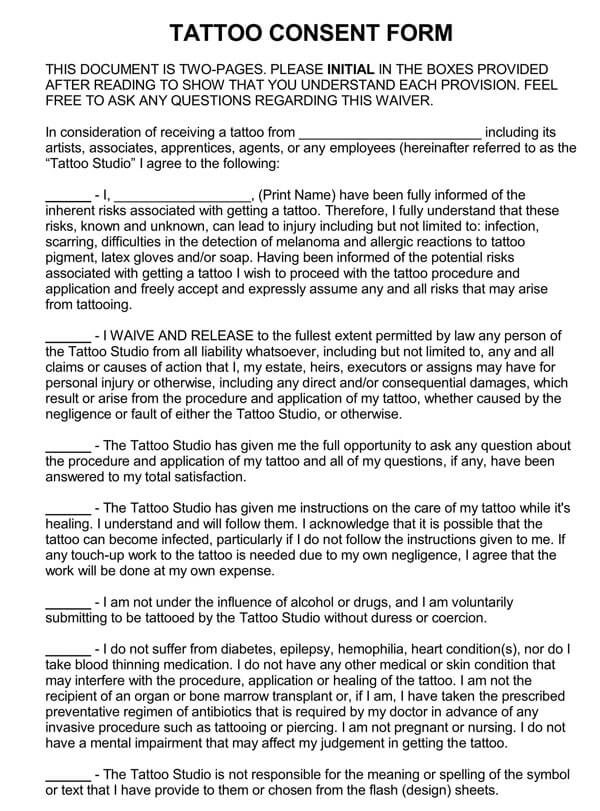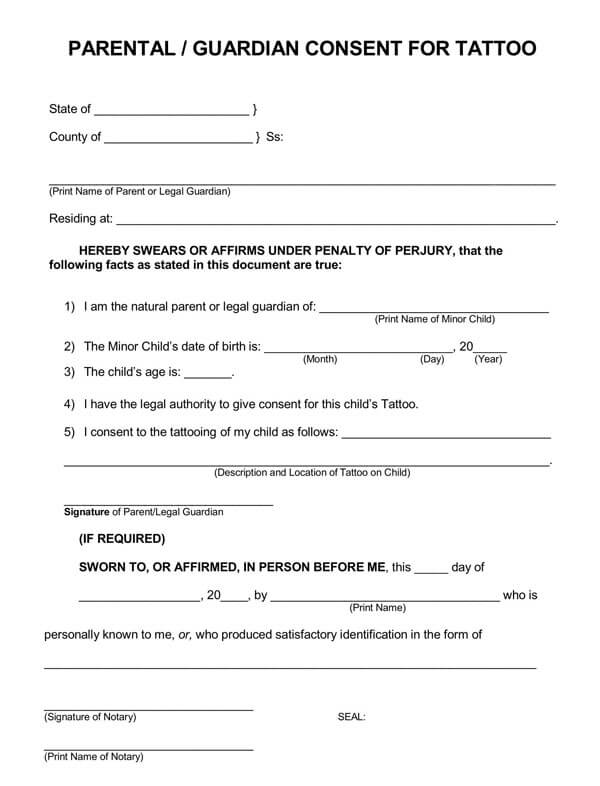A Tattoo Consent Form is defined as a document used by people intending to get a tattoo to declare that the tattoo artist is exempted from any legal or financial liability in case of unprecedented accidents during and after the tattoo piercing.
Minors who want to get a tattoo have to provide a tattoo consent form signed by their parents or legal to an artist before they can get the tattoo. State laws govern the issue of minors getting tattoos, some strictly prohibit it, and some are more lenient, and therefore the consent form must be compliant with state laws.
Purpose of Tattoo Consent Form
A tattoo consent form is meant to acknowledge that complications such as allergic reactions or skin complications can happen to a person during and after a tattoo. This form frees the tattoo artist from any liability against those complications.
The form also provides information about a client’s medical history to the tattoo artist. This information is necessary because some medical conditions prevent someone from getting tattoos.
Tattoo Consent Form Types
There are two broad categories of tattoo consent forms depending on who is getting the tattoo.
They are:

Adult Tattoo Consent Form
This type of consent form is used by adults to grant the artist permission to tattoo them while freeing them of any liabilities that come with the tattoo.
Download: Microsoft Word (.docx)

Minor Child Tattoo Consent Form
This type of consent form is presented to the tattoo artist to show that the parent and guardian grant their consent for the tattoo artist to tattoo a minor. This tattoo consent form must be signed to be valid.
Download: Microsoft Word (.docx)
Key elements of the Tattoo Consent Form
Before presenting the tattoo consent form to the artist, there are basic items you should ensure to include in the document. These components will appear in different consent forms. However, the particulars will vary depending on the situation.
Key elements of a tattoo consent form are:
- Tattoo studio details: The form ought to identify the tattoo studio where you will be getting the tattoo. Indicate the name of the studio in order to protect all the artists and employees of the tattoo studio from accidents that can happen that are not even related to the actual tattooing process.
- Individual details: The document should identify the person getting the tattoo. Therefore, state your full name.
- Consent: A declaration should then be provided stating the individual has read and understood the terms of the consent form and they give their consent to be tattooed. This section absolves the tattoo studio from any health risks and legal damages that might be stemmed from the tattooing process.
- Additional clauses: The form should outline all the terms and liabilities the artist is exempted from. These liabilities are outlined in terms of clauses. You are expected to agree to all the clauses in this section. The clauses assure the artist that you have no underlying medical or psychological condition that can lead to complications with the tattooing process.
Components of an Adult Tattoo Consent Form
Below are the components any individual of legal age should include when preparing a consent form to present to the tattoo artist.
They include:
The name and address of the studio
The first element is the identification of the tattoo studio where you will be getting the tattoo. The official name of the studio should be used. The document should state that the form exempts all the studio’s artists, agents, apprentices, associates, and employees.
Name and signature of the individual getting a tattoo
The form ought to indicate the person getting the tattoo and include his or her signature. It should be clear they are the studio’s client or typically referred to as “patron.” The signature is meant to state that he or she agrees to the contents provided below in the document.
Consent to waive the studio of any inconvenience
The form should then outline the patron’s consent to waive the mentioned studio from any personal injury, accidents, or otherwise, that might occur during the tattooing process.
Consent to answer any additional medical information
The patron’s declaration that they were given an opportunity to raise questions regarding the procedure and the answers were satisfactorily answered should be included. The consent is thus given to proceed with the procedure despite the answers given.
Consent for any infection caused
The form should give the artist consent to carry out the procedure despite the wounds (immediate and probable) associated with the tattoo. This section also indicates that the artists issued the proper instructions for care and treatment of the wound during the healing process, and any touch-up process will be done at their own expense. Finally, it absolves the artist from any liabilities associated with neglect of the wound.
Consent to be free of toxications
The patron should declare that they are free from any intoxication such as alcohol or other drugs. This declaration states the individual agrees to the consent form and is getting the tattoo with a sound mind and at their will.
Consent to provide any medical condition
The form ought to declare whether the patron has medical conditions that can lead to complications with getting a tattoo and interfere with the healing process. The medical conditions should be explicitly listed and not implied.
Consent to the disclaimer of any symbol
Patrons who intend to have a tattoo with a symbol should consent the artist to tattoo the symbol. This consent should exempt the studio from being responsible for its meaning or interpretation.
Color and change of appearance
The document ought to state that the patron understands there may be variations between what they chose and the final tattoo in terms of color, outlook, and might fade in the future. The patron should also be aware that it’s a change of appearance and could be removed either by surgery or laser. By agreeing to this possibility, the patron exempts the artist from applicable liabilities.
Consent to be photographed
In some instances, the studio might take pictures of the tattoo as a record of work done. In such a case, the patron might have to release their rights to the photographs. Therefore, this section declares the patron gives the studio the right to take and use the photographs.
Refund policy and legal actions consent
The tattoo studio’s no-refund policy should appear in the tattoo consent form. The patron agrees to it by signing the form.
Details and signature of the individual
The last item on the adult consent form is the information of the patron and his or her signature after getting ample amount of time to consider the decision. Finally, the patron should sign the document. The signature binds the patron to the terms laid out in the consent form. After the signature, the name, address, date of birth, city, county, state of residence should be provided for any future litigation and dispute.
Standard Tattoo Consent Forms
Components of a Minor (Child) Tattoo Consent Form
A minor tattoo consent form is slightly different from that of an adult. Certain components should appear in the consent form of a minor intending to get a tattoo.
These are:
- The name of state- Permission for minors to get tattoos is subject to state laws. Therefore, the consent form should then state the applicable jurisdiction by indicating the name of the minor’s state of residence.
- County’s name- To identify the relevant state laws.
- Guardian’s name –This shows that a minor is getting the tattoo with the mentioned parent’s knowledge and consent. If the minor is under a legal guardian, then their name should be provided instead.
- Guardian’s address-Contact information is necessary should there be a need for communication in case of any emergency or after the tattooing process.
- Name of minor-The name should be written as it appears on official documents.
- Birthdate of minor- Ensure to write down the day, month and year.
- Age of minor- To affirm if minor is eligible to get the tattoo under state laws.
- Description and location of the tattoo-The tattoo studio should be identified in the tattoo consent form. Information such as the name of the studio and its location should be provided.
- Signature of parent/guardian-To declare that the parent gives their consent to the minor being tattooed, he or she should provide a signature to this effect.
- Notary public consent –In some states, the consent form will have to be notarized as a requirement. If this is the case, the form should have a declaration that the notary public can authenticate the document after verification of the form of identification given by the parent/guardian.
- Notary public signature –A signature by the notary public should then be provided after the notary public declaration. This shows that the notary agrees to the declaration.
- Notary public seal –The last component of a minor tattoo consent form is the notary public seal. The seal declares that the document is valid in the mentioned state, and its laws can be consulted in its execution.
Minor Tattoo Consent State Laws
There are a few States where certain minor tattoo consent laws apply.
Some of these are as follows:
Final Words
A tattoo consent form is a must-have document for anyone intending to get a tattoo. Most tattoo artists will often decline to tattoo an individual without the form. The two common types of tattoo consent forms are adult tattoo consent forms and minor tattoo consent forms. When creating the consent form, ensure to disclose any existing allergies or medical conditions for the artist to determine if you are qualified to get the tattoo. This helps in avoiding complications during and after the process.










